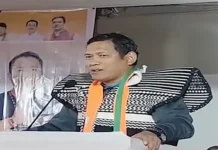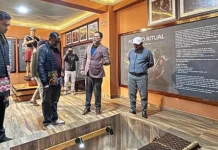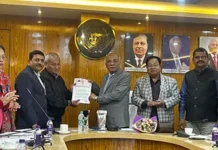[ Aphu Avia Ngwazah ]
The citizens of the international border circle, Vijoynagar, feel comforted by Governor BD Mishra and local legislator K Mosang’s taking stock of the prevailing developmental situation concerned with fundamental human rights of the people. There is hope now that things will get better.
Now that the governor himself is behind the Vijoynagar road project, we believe the road will become motorable once again. We still recall that the then lieutenant governor, KAA Raja, had come to Vijoynagar with a fleet of 12 jeeps in 1975.
Indeed, the deplorable condition of border villages like Gandhigram, Sidiku, etc, had caught the attention of the central government also.
Chairperson of the National Commission for Scheduled Tribes (NCST), Nandkumar Sai, also emphatically instructed the government of Arunachal to “take immediate action to provide infrastructures like road, electricity, water supply, medical facilities, education, etc, in the tribal area.”
This instruction was given on 1 May, 2018, to the state’s SJETA secretary, in the presence of Yobin public leaders and officials of the union tribal affairs ministry, at the NCST office in New Delhi.
However, the situation has not changed for the better.
The July 2019 Lok Sabha presentation by MP Tapir Gao on the plight of Vijoynagar is indeed true, though not at all exhaustive. He mentioned that the price of a bag of cement has touched Rs 7000 and a kilogram of common salt is sold at Rs 200. And this runs contrary to the governments’ policy of ‘development from the border areas’.
May we plead with our proficient governor to bring the price of a bag of cement down to at least Rs 1000 and that of a kg of salt to some Rs 50? This will bring smiles on the faces of the waiting public.
Border villages like Sidi and Dawodi/Jahu-Natu have much geopolitical and historical significance. According to major general DK Palit, major Sumer Singh of the 7th Assam Rifles, during the Chaukan Pass Expedition of 1961, ran into the Yobin tribe’s “village Sidi which he renamed as Gandhigram…”.
Then in the late 1960s, the then chief of air staff, PC Lal, installed a bust of Mahatma Gandhi, as if to match the name with a symbol. Gandhiji’s statue still stands. Symbolically, even the Father of the Nation suffers hardships with the people Gandhigram.
Again, in October 1961-62, the then inspector general of the Assam Rifles, Ajit Singh Gureya, pushed the expedition further up from Sidi/Gandhigram towards the present Dawodi or Vijoynagar and beyond.
It was during this expedition that “Vijoynagar” began to be familiar to the rest of India. Vijoynagar was a Yobin village called Dawodi or Jahu-Natu.
“The place, locally called Jahu-Natu, has been named Vijoynagar after the name of the son of Maj Gen AS Gureya, in 1962.” This is how the Yobin village Dawodi or Jahu-Natu was replaced with “Vijay Nagar” (Ref The Gazetteer of India/ Arunachal Pradesh/Tirap District, 1980, Pg 233).
Unfortunately, these days people laugh as to why the area is still called Vijoynagar, which means ‘victorious town’. People are somehow not able to feel ‘victorious’ when there is no road. Nevertheless, the Yobin tribe of Vijoynagar circle has contributed much to the geopolitical formation of the area. The contributions have now been appreciated by the state, even with gold medals.
Commending the Yobin tribe, Chief Minister Pema Khandu wrote, “If Vijaynagar is part of India today, it’s because of men like Pisi La Singpho, Choegey Yobin and Akhi Yeliye Yobin, who helped the Indian administration consolidate its rule over the area in the 1960-70s, when the Indo-Myanmar borders were not clearly demarcated.”
It may be noted that it was only in 1972 that joint teams of India and Myanmar undertook a boundary survey, and boundary pillars were erected. It is common knowledge that the Yobin at that time had “helped the government authorities in demarcation of the international boundary line and do so even today when the boundary pillars are examined.” (Shalini Verma, Secy SJETA, GoAP. FN Secy (SW) SC/ST (IN-EX) 99, dated 25 Novemver, 2013, Pg 3).
However, the Yobin tribe is still living without much participation in power-sharing for no known or valid reasons. There is not a single Yobin officer in the Arunachal Pradesh government. Not even a Yobin peon is found in entire Itanagar. Nevertheless, the Yobin tribe goes on with dignity, confidence, industriousness and gentleness.
Now, as we zero in on the Miao-Vijoynagar road, we find that lack of motorable road is being used as an excuse for the ailments of the circle. But that is not the sole fact. We want everyone to know that Vijoynagar road construction started sometime in 1966. By 1975, lieutenant governor Raja visited Gandhigram and Vijoynagar on his jeep. Concrete culverts and metal bridges were placed upto some 40th Mile. The rest of the road just had wood bridges.
Then there came a temporary ban from the forest/wildlife department, but that was lifted too. They have also accepted the fact that the park came later while the aborigines have been living here even before the area became an Indian territory. It did not make sense to cut off an entire administrative circle without surface connectivity. Doing so was undermining the fundamental rights enshrined in the constitution of the country.
If we stop and think, we fail to understand how the then PWD or CPWD could make that road in the 1960s and the ’70s, all manually and successfully, but then the subsequent road works by reputed companies/departments with heavy machineries and hefty sanctions could not produce the road. People fail to understand why the road construction is always done as little as possible. Most part of the year, one can see the earthmovers and other equipments lying here and there along the way. But they always come up with fine-sounding, eye-washing explanations as to why the road could not be constructed. The general public feels that there is a lack of commitment to actually do the road.
After the 40th Mile or Burma Nallah, there is not a single concrete or metal bridge. More than 60 percent of the road has no concrete culverts. After the 40th Mile, they always made wooden bridges that do not last. Please do not be surprised that there is no road. If anyone chooses to perform tasks with unethical, quick-fix, fast money-grabbing attitude, we shall never see anything of value, let alone the Vijoynagar road.
Of course everyone understands the importance of this road. Advocacies, sanctions, work executions, fund utilizations had been there. But there was lack of proper monitoring, and the road cannot be seen till now.
Former union rural development minister Jairam Ramesh had come to Miao in February 2013 and promised that the road would be constructed. He initiated some Rs 268 crore for the project under the PMGSY. Six years later, the road-making hasn’t progressed much, and the people still walk for four or five days just to get home or to the nearest town.
However, now we are confident that the present contractors, authorities concerned and all related machineries will not rest without producing the road. Otherwise, we should no longer waste public money on a road that is taking 53 years to complete. In fact, they should have long surrendered and given it to the BRO. The BRO does. They can.
You may agree that the Miao-Vijoynagar road is, by and large, a piece of cake compared to other roads made in the state. It just needs continued, regular, systematic, monitored efforts. They did it in the 1960s, all manually, using spades, axes and wheelbarrows. Vehicles plied there till the late 1970s and the early ’80s. No one should be made to think that it is a ‘Mission: Impossible’ road. It is not. Just come and see.
The road as it is now is difficult, but not impossible. Last December, Sun Bahadur Pun ventured to Vijoynagar with TC trucks and earth movers. The trip was a remarkable one. It took him several months to come back to Miao, and by that time some of the loaded commodities perished. Farmers incurred heavy loses.
One might also recall that several Bolero pickups and tractors have made it to Gandhigram and Dawodi, and are in use currently. So the challenges are hilariously real, and yet there is a way where there is political will.
Meanwhile, in this tryst and suffering of geographical isolation, development bypass, and basic human rights violations, it is not only the aboriginal Yobin tribe but also the retired Assam Rifles pensioner families who were brought there during the 4th Five Year Plan who suffer. The settlers comprised five or six different language groups, but mostly Nepali speakers had been settled in the valley. They, too, share our cup of difficulties and hardships.
We express our gratefulness to the Raj Bhavan and the government for noticing and championing the cause of the less known people who are the identity of India along the Changlang frontier. We trust things will look up from now on.
(The contributor is the general secretary of the Yobin Tribe Fundamental Rights Forum. He can be contacted at aviafisher@gmail.com)



